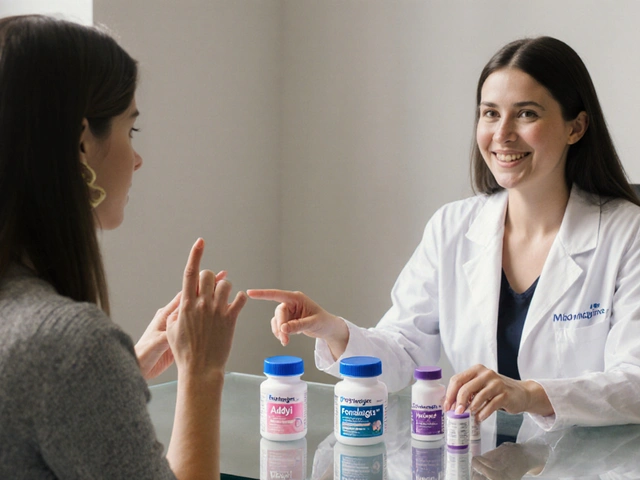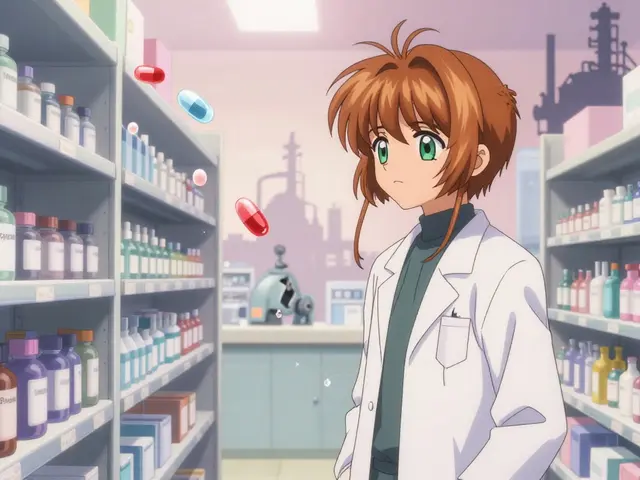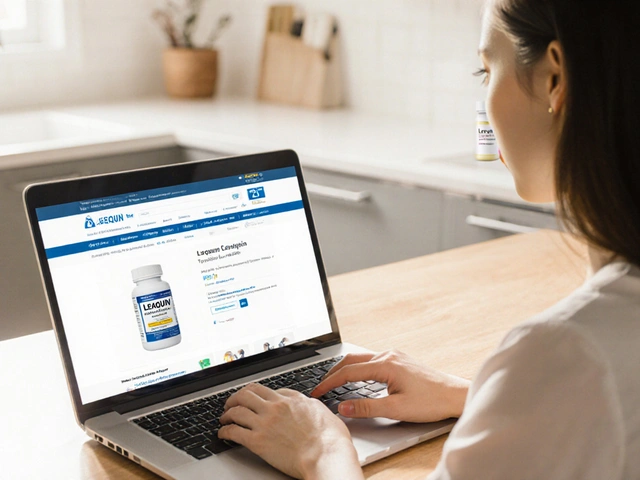Only a handful of tiny tubes in my bathroom scare me as much as the one with 'halobetasol propionate 0.05%' on the label. Potent prescription creams like this one can—quite literally—work miracles on angry rashes, but they’re no joke. If your doctor gave you halobetasol, you might wonder: just how risky is this stuff? Not many people pause to think about these “magic” topical steroids, but maybe they should. The safety profile of halobetasol is surprisingly complex—and sometimes misunderstood. If you have kids, thin or sensitive skin, or a nervous streak (like me and my cat Phlox, who hides when I even open the medicine cabinet), listen up.
What Is Halobetasol and Why Is It Considered Potent?
Halobetasol cream is often reserved for only the toughest of skin wars: think severe plaque psoriasis, stubborn eczema flares, or lichen planus that refuses to move out. It’s part of a group called “ultra-high potency” topical corticosteroids—not your average over-the-counter stuff. In the steroid hierarchy, this is the grandmaster, twenty to thirty times stronger than over-the-counter hydrocortisone. It acts fast, calming down immune chaos in your skin in just days. But that power is a double-edged sword: the stronger a steroid, the higher the risk of side effects.
Doctors only prescribe halobetasol when weaker creams fail or when someone is in visible misery. To give you perspective, typical dosing goes like this: apply a thin layer, once or twice daily, for two weeks. That’s often the absolute max, sometimes shorter—because staying on it for too long is what gets people in trouble. Anything more, and you’re inviting not-so-fun problems like thinning skin, stretch marks, or even a Cushingoid appearance—those puffy cheeks and weight gain that look nothing like you on last year’s driver’s license.
Here’s something even seasoned patients sometimes miss: halobetasol (and other strong steroids) can be absorbed into the bloodstream. This rarely happens with the weaker, over-the-counter creams, but with halobetasol it’s a real risk, especially when you use it over large patches of skin, on your face, or under airtight dressings. It’s the reason doctors warn you like a broken record: don’t use it longer than prescribed, don’t use more than you need, and skip areas like the groin, armpits, or eyelids unless your dermatologist says otherwise.
| Corticosteroid | Potency | Typical Use Duration |
|---|---|---|
| Hydrocortisone 1% | Low | Months |
| Triamcinolone 0.1% | Medium | 2–4 Weeks |
| Betamethasone dipropionate 0.05% | High | Up to 2 Weeks |
| Halobetasol propionate 0.05% | Ultra-high | Up to 2 Weeks |
When it comes to children, doctors are even stricter. Their skin is thinner, and they soak up meds like a sponge. One study from 2023 found that kids given high-potency steroids like halobetasol were almost twice as likely to develop skin thinning if used longer than 7 days. Bottom line: not for tiny humans, unless your prescribing doc is a skin specialist who’s done the math and weighed the risks. And using it for diaper rashes? Please, no. Even Phlox knows to steer clear.

Known Side Effects: What You Might Actually Notice
The most common side effects of halobetasol are all about your skin screaming for help: burning, stinging, redness, or itching when you first apply it. These usually fade as your body gets used to the medication, and for most adults, these early twinges aren’t much more dramatic than quick sunburn flushes. But stick with it for too long, and that’s when things get messy.
One of the biggest fears about halobetasol safety is skin thinning, called ‘atrophy’ in dermatology talk. This means your skin becomes see-through, fragile, crinkly—kind of like tissue paper. Why? Steroids break down collagen if you let them hang around too long. In a 2022 clinical review, up to 8% of long-term users developed clinically significant atrophy after three weeks of daily halobetasol use. Stretch marks (striae), tiny bruises with no explanation, or visible blood vessels are also telltale signs.
Here’s a tip from real-life patients: Always check your skin closely, and bring a flashlight if you must. If you see purple stretch marks, or your skin bruises when you just glance at a doorknob, it’s time to call your doc. Don’t assume “more steroid, more healing.”
People get nervous about systemic absorption—and for good reason. Too much halobetasol soaked into your body can depress your adrenal glands, those hormone factories sitting atop your kidneys. What does that look like? Fatigue, headaches, nausea, weight gain, blood pressure that won’t budge—sometimes even mood changes. These are rare with proper use, but they’re not an urban legend: there were real cases in 2020 where adults using a whole-body application for months developed full-blown steroid hormone issues.
Check this quick list of skin and systemic side effects linked to halobetasol:
- Skin burning, irritation, or dryness
- Itching or redness
- Acne, especially around the mouth or on cheeks
- Thinning, bruising, or stretch marks
- Delayed wound healing
- Changes in pigmentation (light or dark spots)
- Overgrowth of bacteria, yeast, or and even tiny warts
- Signs of hormone imbalance, if huge areas are treated for a long time
But wait: never just stop a potent steroid suddenly if you’ve been using it daily for weeks. Taper down as instructed, because your skin can rebound with a red, itchy vengeance. This “steroid withdrawal syndrome” is rare but can make your initial rash look like child’s play. Your dermatologist will give you a plan for safely lowering your dose or switching to milder creams as you heal.
Pro tip: Never cover the treated area with tight bandages (unless your doctor’s written it out for you), and avoid using halobetasol under diapers, plastic wraps, or in skin folds. That’s where most bad reactions pop up.

Best Practices for Safe Use and Who Should Avoid It
Getting the most out of halobetasol—and staying safe—means following a handful of golden rules. Always apply it sparingly. Think “pea-size for a palm-size patch,” and not a glob for your entire arm. Too much won’t make your rash go away any faster and could make things much worse. My dermatologist friend says: “When in doubt, use less.”
Another key safety tip: always wash your hands after applying, unless you’re treating your hands themselves. This avoids getting halobetasol in your eyes, where it can cause a whole new set of issues. If you need to use a moisturizer, let it absorb for at least 15 minutes before applying halobetasol. Mixing them together isn’t as effective, and oils or lotions can mess with how deeply the steroid gets into your skin.
If you have infections—like untreated cold sores, warts, or athlete’s foot—on the same area, talk with your doctor first. Halobetasol slows down your immune system locally, which can make skin infections worse or hide them until they’re raging. The same warning applies to people with thin, fragile skin, diabetic patients (steroids can bump up blood sugar), and anyone pregnant or breastfeeding. In those situations, sometimes even weaker topical steroids are a no-go. The official recommendation? No use in pregnancy unless your specialist agrees the benefits outweigh the risks.
Here’s a checklist for anyone starting halobetasol:
- Double-check the prescription: is it for a stubborn rash, like psoriasis or severe eczema?
- Ask your doc about the shortest safe use window, and what milder options could work after.
- Apply the thinnest layer possible, just on affected skin—never blanket-coverage.
- Never use it on your face, groin, or armpits, unless specifically directed.
- Tell your dermatologist if you notice any new bruising, stretch marks, or swelling.
- Store it out of reach of children and pets (my cat Phlox once chewed a totally closed ointment tube, so trust me on this).
If you’re a data geek, here’s what’s neat: A 2024 New England Derm Journal report showed that following strict application guidelines slashed skin thinning risk to less than 2% in adults, compared to 7–8% in people who didn’t follow instructions. Those odds are worth the extra two seconds to read the label. Plus, follow-ups matter. Plan check-ins with your provider if your rash stubbornly stays or spreads. Sometimes what looks like eczema is actually something else, and pumping up the steroid dose won’t fix it.
Big takeaway? Halobetasol can be a game-changer when your skin feels impossible to live with, but cutting corners or being careless is a recipe for long-term trouble. Don’t DIY or refill old prescriptions just because you “know your skin.” When in doubt, ask your derm. And if your cat looks suspicious whenever you reach for a tube, maybe that’s a good reminder to double-check—because safety with strong steroid creams isn’t about being scared, it’s about being smart.








13 Comments
Matt Stone
July 10, 2025 AT 00:15Halobetasol is definitely not something to mess around with. It’s one of the strongest steroid creams out there and you have to be really careful about how long you use it. Overuse can lead to skin thinning and other nasty side effects.
That said, it can be a lifesaver for certain skin conditions like psoriasis or severe eczema if used correctly. I always wonder why some people think using it without a doctor’s guidance is a good idea. It can suppress your immune response locally, which can cause issues if you have infections.
Anyone here had any experience with halobetasol? How did your dermatologist advise you to use it?
Akshay Pure
July 10, 2025 AT 17:55It's quite alarming how casually potent steroids are sometimes recommended or used by the general public. Halobetasol, being a super high-potency corticosteroid, requires a judicious and sophisticated understanding of its pharmacodynamics.
One cannot underestimate the risks of epidermal atrophy or systemic absorption leading to hypothalamic-pituitary-adrenal (HPA) axis suppression. Not to mention the paradoxical rebound dermatitis when abruptly stopping the medication.
The lay discourse needs to elevate when discussing such potent drugs. They are not toys, after all.
Heather Jackson
July 11, 2025 AT 04:02Oh gosh, I actually got prescribed halobetasol for a pretty rough patch of eczema last winter. At first, I was kinda scared because of the warnings and all but it really helped clear up my skin.
I was careful to only apply a thin layer and only for the time my doctor said. The tricky part was not overdoing it because it could make your skin worse after some time, which is what I feared!
Definitely not something to try on your own, especially if your skin isn't that bad. Always check with a doc!
Michelle Abbott
July 11, 2025 AT 15:25To add, halobetasol’s chemical properties as a fluorinated corticosteroid mean it has high skin penetration. This pharmacokinetic aspect is crucial when considering both efficacy and risk.
Many patients underestimate how even minimal overdosing or prolonged use can precipitate cutaneous adverse events. Not to mention the rare but serious systemic ramifications when used on large surface areas or under occlusion.
Therefore, this medication’s safety profile demands rigorous clinical oversight. Anyone disregarding this risks severe dermal damage.
Steven Macy
July 12, 2025 AT 19:28It's interesting to think about how much trust we put in topical medications like halobetasol. On one hand, they provide immediate relief for uncomfortable conditions; on the other, the potential side effects can be quite serious.
In my opinion, education on proper use and access to dermatological advice are key to ensuring these drugs do more good than harm. This balance between benefit and risk needs constant evaluation.
Does anyone know how common it is for patients to develop steroid withdrawal symptoms after stopping halobetasol?
Pam Mickelson
July 13, 2025 AT 23:32Great points made so far! Just want to remind everyone, if you’re prescribed halobetasol, always follow the prescribed dosage and time frame. It’s usually advised not to use it longer than two weeks to avoid complications like skin thinning or stretch marks.
Also, it's best avoided on sensitive areas like the face unless specifically directed by a healthcare provider. Keeping the skin moisturized and avoiding irritants during treatment can enhance outcomes.
Remember, communication with your dermatologist is key.
Ada Lusardi
July 15, 2025 AT 03:35OMG, I used halobetasol once and honestly it felt like magic for my psoriasis patches✨ But I got super paranoid about overdoing it and stopped after a week!
At one point, my skin did feel a bit weird and more sensitive which scared me. Has anyone else felt that? 🙋♀️
Also, the smell isn’t exactly pleasant but the results kinda make up for it. Just remember everyone, don't go overboard!
Doug Farley
July 16, 2025 AT 07:38Yeah, miracle cream and nightmare in a tube rolled into one. Halobetasol is often hyped up by folks who don’t get the bigger picture—like how long-term or inappropriate use inevitably wrecks your skin barrier.
And of course, the ‘doctor knows best’ line gets thrown around, but sometimes even the doc’s advice can be overly aggressive with these super potent steroids.
Skin damage? Check. Dependency? Check. Steroid rosacea? All day long. People really should think twice before slathering this stuff everywhere.
Joe V
July 17, 2025 AT 11:42While it’s important to be wary of side effects, I find some of the fear-mongering around halobetasol quite excessive. When used correctly, it’s a highly effective therapeutic agent that significantly improves quality of life for many patients.
Sure, monitoring is necessary, but dismissing it outright ignores the well-established benefits under medical supervision.
It’s all about responsible usage and patient education rather than panic.
Scott Davis
July 18, 2025 AT 15:45I agree the concerns are real but so are the benefits for those who need it. Halobetasol is not for casual use, but those serious about managing tough skin issues can find relief with it.
What seems to matter most is tailoring treatment individually and regular checkups to avoid complications.
Has anyone experienced positive results without side effects?
Matt Stone
July 19, 2025 AT 19:48@Scott Davis Yeah I’ve seen plenty of cases where patients suffered from improper use, especially stopping abruptly after prolonged courses. It can cause a rebound effect that aggravates the original condition.
That’s why gradual tapering or alternate therapies might be better in certain scenarios.
Steven Macy
July 20, 2025 AT 23:52@Matt Stone Very informative, I appreciate the concise points. Gradual tapering does make clinical sense to mitigate withdrawal reactions.
Supporting patient education with clear guidelines reduces misuse significantly.
Michelle Abbott
July 22, 2025 AT 03:55@Heather Jackson Your experience highlights how real-world use is often a balance between efficacy and side effect management. Sensitivity after use is common and should alert users to scale back or consult a professional.
Thanks for sharing your story, it’s valuable insight.